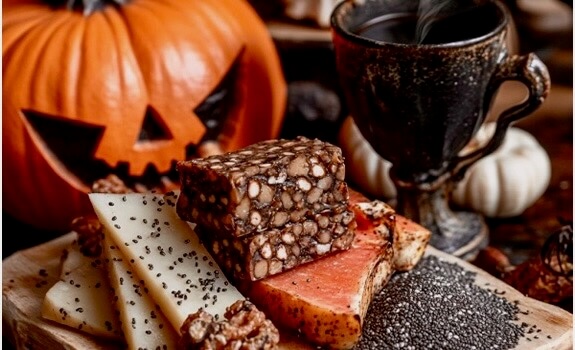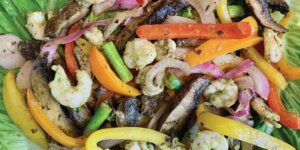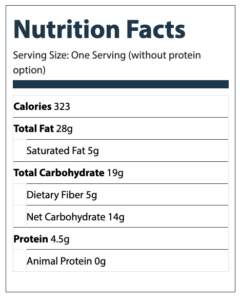October 22, 2024
Spooky Foods

By Valerie Driscoll, Lead Coach and Coaching Program Developer for Apollo Health
Scary MUSIC CUE: 🎼 do do do do; do do do do; do do do do …
This, my friends, is a tale of Spooky Foods: a warning here if you are triggered by turnip greens, shake from shiitake, or are alarmed by alaria (brown algae), but know that this terrifying tale has a happy ending.
Zoom in on a tired and hungry diner sitting in a pleasant and over-priced restaurant:
“Not possible,” she thought as she looked down at the coaster-sized slab of protein sitting atop the large salad. “There is absolutely no way that a self-proclaimed chef, in a restaurant of this caliber, grilled a solid piece of tempeh and then threw it on top of this salad.”
She was partially incorrect, being mistaken that the chef had thrown the tempeh on the salad but had neglected to grill it – having only removed the packaging and cut the slab in half before sending it on its way. She imagined him saying, “TAKE THAT, you stinking vegetarian; how dare you insult my culinary capabilities by forcing me to cook a food I know nothing about!” Who knows what sordid thoughts went through his mind when the diner sent back the tempeh with the instructions to “cut it into bite-size pieces, season it, and sauté it in olive oil until cooked through.”
🎼 do do do do; do do do do; do do do do …
Narrator: Imagine, if you will, a food so terrifying that despite your culinary training, a quarter of a year to consider preparing it, and a world of information at your fingers via Google search, you simply unwrapped it, hacked it in half and rid it from your kitchen as quickly as possible.
🎼 do do do do; do do do do; do do do do …
This story, without any exaggeration, happened to me last week on a group trip I was facilitating. It inspired this piece, as I realized that my life, partly due to The Bredesen Protocol, is now filled with Spooky Foods: food I now eat regularly but are so unfamiliar to the masses that it renders — even professionals — terrified.
I thought that running through a few spooky foods from the Apollo Grocery Guide might encourage some of you, currently quaking at the thought, to try them out. All are delicious, nutrient-dense, and great for your brain. My experience as a Mastering Nutrition for Cognition with KetoFLEX 12/3 facilitator for our members is that as the palette begins to cleanse away from sweets, seed oils, and heavily processed fare, foods deemed “yucky” go straight to “yum”!
I am going to share some of my favorite spooky foods below. Recipes to prepare them, you ask? We’ve got those aplenty on our member site – even one that will show you how to cook the aforementioned scary tempeh easily and deliciously.
Enter if you dare …
Chicories are bitter-flavored leafy vegetables related to lettuce and are in season right now! We know them as endive, frisée, escarole, and radicchio. They give a lovely bitterness to salads if added raw, but they are so hardy that they also lend themselves to being lightly sautéed or roasted, either alone or in a medley of veggies, at 400 with some garlic, EVOO, salt, and pepper!
Our recipes for Radicchio, Apple, and Arugula Salad and Roasted Veggies for our members include chicory, adding one or more chicories to the mix.
Jicama is a prebiotic root vegetable with thick, brown skin and white flesh. It tastes like an apple but not as sweet, a bit like a potato, but with fewer carbs. Its potato-likeness lends it to making delicious fries, which are crazy easy to make. We gave our members a substitute for French fries using Jicama in the recipe Jicama Fries.
Chia Seeds are super-nutritious mini packages of yumminess through which I have cured many clients of their oatmeal fix. I like to combine them with hemp hearts to make either a sweetish or savory pudding with non-dairy milk or yogurt. You can add nuts, a few berries, or my favorite savory topping: an egg, fresh herbs, and pepitas! They have fiber, Omega 3s, calcium, and so much more. I also love them as a smoothie thickener, too.
If you want to sprout them (and then tell your grandkids about the chia pets you raised in 1975?), our members can learn how here.
Our recipe for our members features chia seeds; Cranberry Almond Chia Pudding serves as a base for 48 other ideas.
Tempeh “Just cut it in half and throw it on a plate” — Professionally trained chef, Cape May, NJ.
Tempeh, an Indonesian food made from fermented soybeans, is an important fermented food! It is a good source of protein and is so versatile that it can be used in a variety of ways and with about any flavor profile you can imagine.
Use it with our fabulous new Flavor Profiles members’ guide! Throw it in some bone broth with sea veggies (another scary food). OR use it in one of my favorite recipes, Rainbow Fajitas featuring Tempeh:
Rainbow Fajitas

Including almost every color of the rainbow, this easy-to-make fajita dish is packed with Tex-Mex flavors. This sizzling staple can be served in many ways: serve it on its own — simply topped with avocado, paired with our tortillas, or in a lettuce cup, or use it to top a taco salad. Whichever way you decide to serve it.
Yield: Four servings
Ingredients:
• 1/2 cup high polyphenol extra virgin olive oil (EVOO)
• 15 sprigs cilantro
• 1 lb protein of choice: wild-caught shrimp, USDA grass-fed beef, thinly sliced, or USDA organic tempeh, thinly sliced
• 2 red onions, thinly sliced
• 4 portobello mushroom caps, sliced
• 2 bell peppers, USDA organic, seeded and sliced
• 1 cups asparagus, chopped
• 4 cloves garlic
• 2 limes, juiced, plus more for serving
• 4 tsp cumin, ground
• 4 tsp paprika
• 2 tsp onion powder
• Salt to taste
Directions:
1. Preheat the oven to 400 °F.
2. Place the cilantro, EVOO, garlic, lime juice, cumin, paprika, and onion powder in a high-speed blender and blend until well-mixed.
3. Add salt to taste and blend more.
4. Place your protein of choice and all the vegetables in a large bowl.
5. Pour your marinade over the protein and vegetables and mix well.
6. Cover and refrigerate for 30 minutes.
7. Lightly grease a large sheet pan.
8. Place your fajitas on the pan evenly in one layer.
9. Bake for 15 to 30 minutes, depending on the protein of choice. Shrimp should take 15 minutes, while tempeh and steak can take a little longer.
10. Serve with your choice of toppings in a lettuce cup.

Organ Meats Okay, this category even gives me pause, but ancestrally, we ate from snout to tail, and not doing so creates an imbalance in amino acids that can affect health, especially that of the gut. If you want to restore this balance, consider eating other parts of an animal besides muscle meat. To help you in this quest, we have these recommendations:
US Wellness Meats, where you can buy pastured meat and poultry and prepared food like liverwurst and bone broth. If you want to make your own, buy a whole pastured chicken and make your own in a crock pot.
We provide our members with the recipe for Bone Broth for Health.
Nutritionist Sara Tate turned me onto Pluck Seasonings. This seasoning takes the fear out of dealing with edible organs and creates a tasty sprinkle that tastes great on almost anything. These are just a few suggestions; if you are ready to explore other options, remember that our member Grocery Guide is NOT to haunt you but to heal you and that our member Recipe Guides have over 200 ways to make it all delicious! “Boo Appetite!”






